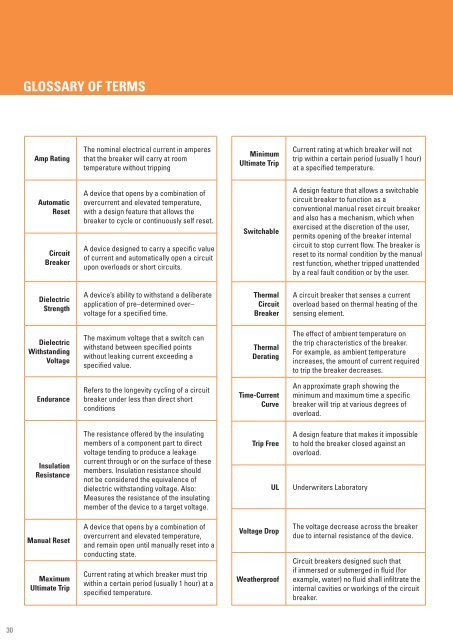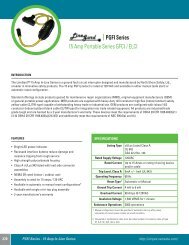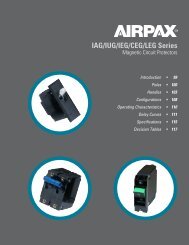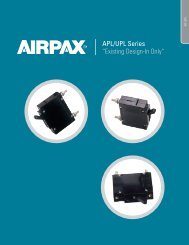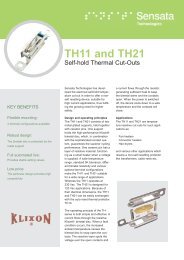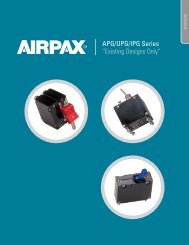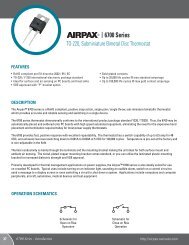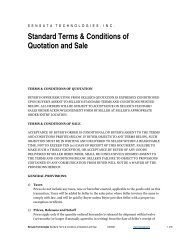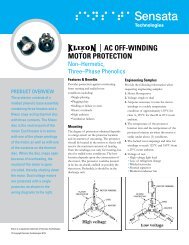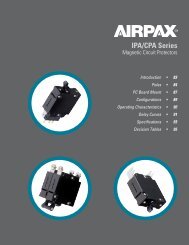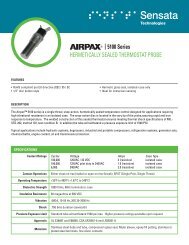KLIXON® thermal circuit breakers are - Sensata
KLIXON® thermal circuit breakers are - Sensata
KLIXON® thermal circuit breakers are - Sensata
Create successful ePaper yourself
Turn your PDF publications into a flip-book with our unique Google optimized e-Paper software.
30<br />
GLOSSARY OF TERMS<br />
Amp Rating<br />
Automatic<br />
Reset<br />
Circuit<br />
Breaker<br />
Dielectric<br />
Strength<br />
Dielectric<br />
Withstanding<br />
Voltage<br />
Endurance<br />
Insulation<br />
Resistance<br />
Manual Reset<br />
Maximum<br />
Ultimate Trip<br />
The nominal electrical current in amperes<br />
that the breaker will carry at room<br />
temperature without tripping<br />
A device that opens by a combination of<br />
overcurrent and elevated temperature,<br />
with a design feature that allows the<br />
breaker to cycle or continuously self reset.<br />
A device designed to carry a specific value<br />
of current and automatically open a <strong>circuit</strong><br />
upon overloads or short <strong>circuit</strong>s.<br />
A device’s ability to withstand a deliberate<br />
application of pre–determined over–<br />
voltage for a specified time.<br />
The maximum voltage that a switch can<br />
withstand between specified points<br />
without leaking current exceeding a<br />
specified value.<br />
Refers to the longevity cycling of a <strong>circuit</strong><br />
breaker under less than direct short<br />
conditions<br />
The resistance offered by the insulating<br />
members of a component part to direct<br />
voltage tending to produce a leakage<br />
current through or on the surface of these<br />
members. Insulation resistance should<br />
not be considered the equivalence of<br />
dielectric withstanding voltage. Also:<br />
Measures the resistance of the insulating<br />
member of the device to a target voltage.<br />
A device that opens by a combination of<br />
overcurrent and elevated temperature,<br />
and remain open until manually reset into a<br />
conducting state.<br />
Current rating at which breaker must trip<br />
within a certain period (usually 1 hour) at a<br />
specified temperature.<br />
Minimum<br />
Ultimate Trip<br />
Switchable<br />
Thermal<br />
Circuit<br />
Breaker<br />
Thermal<br />
Derating<br />
Time-Current<br />
Curve<br />
Trip Free<br />
Voltage Drop<br />
Weatherproof<br />
Current rating at which breaker will not<br />
trip within a certain period (usually 1 hour)<br />
at a specified temperature.<br />
A design feature that allows a switchable<br />
<strong>circuit</strong> breaker to function as a<br />
conventional manual reset <strong>circuit</strong> breaker<br />
and also has a mechanism, which when<br />
exercised at the discretion of the user,<br />
permits opening of the breaker internal<br />
<strong>circuit</strong> to stop current flow. The breaker is<br />
reset to its normal condition by the manual<br />
rest function, whether tripped unattended<br />
by a real fault condition or by the user.<br />
A <strong>circuit</strong> breaker that senses a current<br />
overload based on <strong>thermal</strong> heating of the<br />
sensing element.<br />
The effect of ambient temperature on<br />
the trip characteristics of the breaker.<br />
For example, as ambient temperature<br />
increases, the amount of current required<br />
to trip the breaker decreases.<br />
An approximate graph showing the<br />
minimum and maximum time a specific<br />
breaker will trip at various degrees of<br />
overload.<br />
A design feature that makes it impossible<br />
to hold the breaker closed against an<br />
overload.<br />
UL Underwriters Laboratory<br />
The voltage decrease across the breaker<br />
due to internal resistance of the device.<br />
Circuit <strong>breakers</strong> designed such that<br />
if immersed or submerged in fluid (for<br />
example, water) no fluid shall infiltrate the<br />
internal cavities or workings of the <strong>circuit</strong><br />
breaker.


